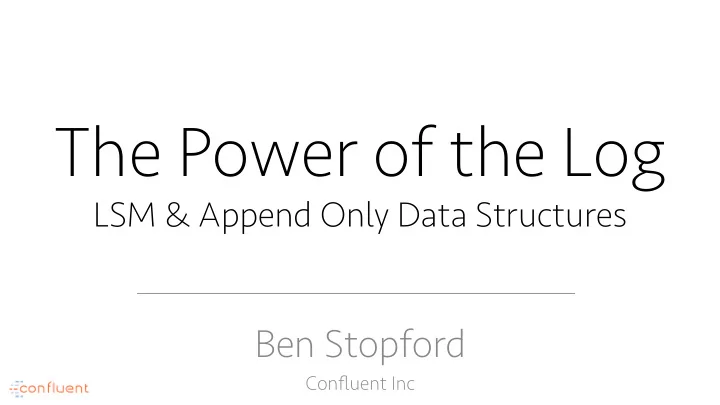

The Power of the Log LSM & Append Only Data Structures Ben Stopford Confluent Inc
@benstopford
Kafka: a Streaming Platform Producer Consumer Connectors Connectors The Log Streaming Engine
KAFKA’s Distributed Log Append Only Linear Scans
Messaging is a Log-Shaped Problem Append Only Linear Scans
Not all problems are Log-Shaped
Many problems benefit from being addressed in a “log-shaped” way
Supporting Lookups
Lookups in a log Head Tail
Trees provide Selectivity Index bob hary mike steve vince dave fred
But the overarching structure implies Dispersed Writes Random IO bob hary mike steve vince dave fred
Log Structured Merge Trees 1996
Used in a range of modern databases • BigTable • MongoDB • HBase • WiredTiger • LevelDB • Cassandra • SQLite4 • MySQL • RocksDB • InfluxDB ...
If a systems have a natural grain, it is one formed of sequential operations which favour locality
Caching & Prefetching Disk Controller Page Cache L3 cache CPU Caches L2 cache L1 cache Pre-fetch is your Application-level caching friend
Write efficiency comes from amortising writes into sequential operations
Taken from ACMQueue: The Pathologies of Big Data
So if we go against the grain of the system, RAM can actually be slower than disk
Going against the grain means dispersed operations that break locality Good Locality Poor Locality
The beauty of the log lies in its sequentially Append Only Linear Scans
LSM is about re-imagining search as as a “log-shaped” problem
Arrange writes to be Append Only Bob = Carpenter Update in Place Ordered File (Random IO) Bob = Cabinet Maker Bob = Carpenter Append Only Journal (Sequential IO) Bob = Cabinet Maker
Avoid dispersed writes
Simple LSM
Writes are collected in memory Writes sort RAM write to disk small older index file files
When enough have buffered, sort. Writes sorted Batched RAM write to disk small older index file files
Write the sorted file to disk Writes sorted Batched write to disk Small, sorted older immutable file files
Repeat... Writes sorted Batched write to disk New files Older files
Batching -> Fast Sequential IO Writes Sorted memtable Batched write to disk New files Older files
That’s the core write path
What about reads?
Search reverse-chronologically (1) Is “bob” here? (3) Is “bob” here? newer older files files (2) Is “bob” here? (4) Is “bob” here?
Worst Case We consult every file
We might have a lot of files!
LSM naturally optimises for writes, over reads This is a reasonable tradeoff to make
Optimizing reads is easier than optimising writes
Optimisation 1 Bound the number of files
Create levels Level-1 Level-0
Separate thread merges old files, de- duplicating them. Level-1 Level-0
Separate thread merges old files, de- duplicating them. Level-1 Level-0
Merging process is reminiscent of merge sort
Take this further with levels Level-3 Memtable Level-2 Level-1 Level-0
But single reads still require many individual lookups: • Number of searches: – 1 per base level – 1 per level above
Optimisation 2 Caching & Friends
Add Memory i.e. More Caching / Pre-fetch
Read Ahead & Prefetch Disk Controller Page Cache L3 cache L2 cache L1 cache Pre-fetch is your friend
If only there was a more efficient way to avoid searching each file!
Elven Magic?
Bloom Filters Bit Set Answers the question: Do I need to look in this file to find the value for this key? Hash Function Size -> probability of false positive Key
Bloom Filters • Space efficient, probabilistic data structure • As keyspace grows: – p(collision) increases – Index size is fixed
Many more degrees of freedom for optimising reads RAM file metadata & bloom filter Disk
Log Structured Merge Trees • A collection of small, immutable indexes • All sequential operations, de-duplicate by merging files • Index/Bloom in RAM to increase read performance
Subtleties • Writes are 1 x IO (blind writes) , rather than 2 x IO’s (read + modify) • Batching writes decreases write amplification. In trees leaf pages must be updated.
Immutability => Simpler locking semantics Only memtable is mutable
Does it work? Lots of real world examples
Measureable in the real world • Innodb vs MyRocks results, taken from Mark Callaghan’s blog: http://bit.ly/2mhWT7p • There are many subtleties. Take all benchmarks with a pinch of salt.
Elements of Beauty • Reframing the problem to be Log-Centric. To go with the grain of the system. • Optimise for the harder problem • Compartmentalises writes (coordination) to a single point. Reads -> immutable structures.
Applies in many other areas • Sequentiality – Databases: write ahead logs – Columnar databases: Merge Joins – Kafka • Immutability – Snapshot isolation over explicit locking. – Replication (state machines replication)
Log-Centric Approaches Work in Applications too
Event Sourcing • Journaling of state changes Journal • No “update in place” + 10.36 - 12.12 + 23.70 Object + 13.33
CQRS Client Query Command log Write Read Optimised Optimised
How Applications or Services share state
Log-Centric Services Read-Replica Writer Read-Replica Writes are localised to a single service Read-Replica
Log-Centric Services Read-Replica Writer Read-Replica Immutable log Read-Replica
Log-Centric Services Read-Replica Writer Read-Replica Many, independent Read-Replica read replicas
Elements of Beauty • Reframing the problem to be Log-Centric. To go with the grain of the system. • Optimise for the harder problem • Compartmentalises writes (coordination) to a single point. Reads -> immutable structures.
Decentralised Design In both database design as well as in application development
The Log is the central building block Pushes us towards the natural grain of the system
The Log A single unifying abstraction
References LSM: • benstopford.com/2015/02/14/log-structured-merge-trees/ • smalldatum.blogspot.co.uk/2017/02/using-modern-sysbench-to-compare.html • www.quora.com/How-does-the-Log-Structured-Merge-Tree-work • bLSM paper: http://bit.ly/2mT7Vje Other • Pat Helland (Immutability) cidrdb.org/cidr2015/Papers/CIDR15_Paper16.pdf • Peter Ballis (Coordination Avoidance): http://bit.ly/2m7XxnI • Jay Kreps: I Heart Logs (O’Reilly 2014) • The Data Dichotomy: http://bit.ly/2hk9c2K
Thank you @benstopford http://benstopford.com ben@confluent.io
Recommend
More recommend